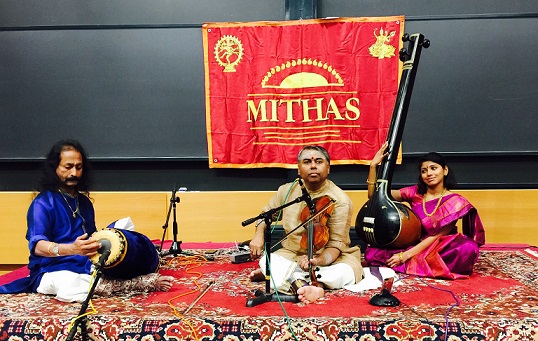On November 6, 2016 the Boston Rasikas were treated to a virtuoso performance by Vidwan Shri R. K. Shriramkumar. He was accompanied on the mridangam by Vidwan Shri J. Vaidyanathan. Shri Shriramkumar and Shri Vaidyanathan are no strangers to the Boston area, having visited and performed on numerous occasions. However, I believe, this was the first time Shri Shriramkumar was performing a violin solo for the Boston audience. He belongs to a rich tradition imbibing his skills from his Grandfather Shri R.K. Venkatarama Sastry, his first Guru Smt. Savitri Satyamurthy, violin legend Naadayogi Dr. V. V. Subramaniam and Sangeetha Kalanidhi Shri D. K. Jayaraman. Shri J. Vaidyanathan is no less when it comes to his musical lineage – his father is Shri D. K. Jayaraman and his guru is Sangeetha Kalanidhi Dr. T. K. Murthy.
If one listens to Shri Shriramkumar accompany anyone, one can realize just how many compositions he knows. And it is not just the compositions he knows in his bani, but how many different “Paatantharams†(styles) he knows. Shriramkumar the person and the artiste are no different. His vidwat radiates in his speech, song and violin. Hari Athanari, the President of MITHAS in his opening remarks aptly compared him to the Physics genius Dr. Richard Feynman. Shri Shriramkumar is a musician who brings out the beauty of the raga by traversing to places where very few seldom attempt to go.
He opened the concert with a leisurely but appropriately paced Heccarikaraga, a composition of Saint Thyagaraja in Yadhukulakambhoji. He followed that with a Madurai Mani Iyer favorite of Saint Thyagaraja, Nijamarmamu in the raga Umaabharanam. This was followed by a spiritual Varali ragam, where one could hear the influences of his Guru Shri VVS and Shri T. N. Krishnan in the raga elaboration. Etijanma another magnum opus of Saint Thyagaraja was presented. Varali was followed by Durusuga, a composition of Syama Sastri, Sri Ramam in Narayanagowla (a rare krithi) and then a sublime Manavyalakim in the ragam Nalinkanthi. Shri Shriramkumar then presented Kharaharapriya in its glorious splendor playing a superb raga alaapana and a brilliant Thanam in a ragamaalika. While playing the Thanam Raagamalika, Shriram played a series of ragams without a break, transitioning from one ragam to the other effortlessly. It is not just the technique that needs to be appreciated here, but aesthetic nature of the presentation – just simply divine. Cakkani Raja was presented and Shri Vaidyanathan presented a most erudite Thani avarthanam that was most appropriate with the ambiance that had been set for the concert. The “Tukkada†pieces, as the 2nd half of a concert is usually unfairly labelled, were just as elegant. A Javali in Khamas, a Meera Bhajan, A Thiruppavai and a Thirupuzhal were presented in chaste fashion.
The beauty of this concert was the command of the compositions that Shri Shriramkumar has – every word of the Sahityam (lyrics) and the Paatantharam (tradition) in each of the composition came through so clearly, that one never felt we were listening to an instrumental concert. The pieces that were presented was a healthy mix of the popular and eclectic and they were handpicked jewels were strung together to give the audience a very sedate, satisfying and blissful experience.
The other jewel in this concert was the mridangam support of Shri J. Vaidyanathan. Soft and soothing strokes with strong and powerful theermanams really proved what Shriramkumar said about JV at the start of the concert – that his mridangam “Singsâ€. The thani that was presented was most appropriate – short, sweet and kept with the ambiance of the concert. I strongly believe that every student of music should listen to live concerts and especially concerts of learned musicians. Apart from being able to deliver technically, a student must understand the planning of a concert. It is a fine line that one has to balance while presenting the concert – technical prowess vs. preserving the musicality and melody. Shriramkumar showed that if one can present the compositions in its grandeur, the music becomes all-pervading and the appreciation automatically comes in. There is so much beauty and layers in our Indian classical music; the deeper you delve in it the more understand and that knowledge comes shining through. Shriramkumar and Vaidyanathan are two such artistes who now showed us common folk as to what depths we can take our music to. Thank you RKSK & JV for such a wonderful evening of music.

